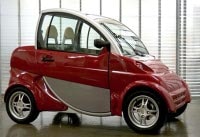... or the cars of the future? This is yet to be determined, but in the last couple of months we have been subject to an all out offensive of the environment friendly all-electric vehicle. It would seem that entrepreneurs all over the world found the answer to humanity's problems over night, as if a divine force came to them and said: "Build an all electric and I shall deliver you from harm!"
But really now, what are the odds of this new El Dorado quest catching on, at least during our lifetime? If you have been watching, you know the struggle is only beginning. But this is not a deterrent for those who dreamt up these contraptions, as they keep on going about their business and come up with odd looking vehicles and out of this world sales forecasts.
The idea of an all electric vehicle has been around for as long as the concept of a self propelled machine has. Sometimes in between 1832 and 1839, Robert Anderson, a Scottish businessman, invented the first electric undercarriage, while the first small scale electric car, based on a design by Sibrandus Stratingh, was built in 1835 by Christopher Becker.
Even if they emerged at about the same time, electric and combustion engines got split up and took separate paths, as one got buried and other became the Mecca of propulsion. Nowadays, when things look like they are about to explode just like the gasoline in the combustion engine, all electric engines came back. With a vengeance.
Eager to tap into this emerging market segment, electric vehicle builders seem to have gotten into their heads the idea that an all-electric vehicle, being alternative, should also look different, or have only three wheels, or eight, or be shaped like a cube, a sphere...
We would like all electric vehicles to succeed and there is a good chance that given the time, they will. It is though unlikely they will do so in the near future. And this is why...
Infrastructure
This is perhaps the EV's biggest challenge and will take some time for it to be overcome. Even if efforts are being made to create it, the concept is so new that not even its guidelines are set yet.
It is safe to assume EV charging stations will first emerge as auxiliary services provided by existing gas stations or road side stores. Just like in the early days of the combustion engine, when gasoline was sold in pharmacies (Germany) or local general stores (US), we will probably see this type of development in EV's case as well.
The first step towards a fully integrated EV charging network was taken in Paris, a city which already has a dense and most of all ready for use network. This is, however, a fortunate case and even if some countries like the UK talk about converting regular gas stations into EV charging ones, the topic is not as simple as it may appear.
You might say "What's the problem? Why can't I charge my EV at a convenience store, or ask some stranger to give me access to one of the plugs in his house?"
The answer is simple. Time. It takes an average 1 to 2 hours to fully charge an EV, so unless you are in the habit of spending a lot of time in homes other than your own, this is not the way to go.
The technology behind EV allows for partial charging, but unless you like stopping every 30, 40 miles for a new dose, you will have to stay put for the whole charging process. This in turn may lead to yet another issue: overcrowding.
The lack of infrastructure and the rules it will have to follow will delay mass success of all electric vehicles. For the time being (we say some 10 to 20 years), EV will remain leisure vehicles, an alternative choice for the weekends in the park or everyday commuting, limited to major cities.
EV manufacturers try to lure us in by highlighting how cost effective an EV is to operate. We don't deny that, but given the fact that at the time there is no viable infrastructure for EVs and you will only get to use the car at the end of the week, for drives around the park, the investment you made will be as constructive as buying ice cream in winter.
By the time it will be worth to buy an EV, those same costs will not be the same. Developing an infrastructure will require money, which in turn will reflect on the price to be paid at the charging station.
Range remains a major issue, as most of the today's EVs have problems in passing the 300 km threshold. From the environmental standpoint, it is hard to believe that anything will change for the better if, five days a week, we all use EVs to go about our business in the city, but over the weekends an army of four wheel drive 20 miles to the gallon monsters will head for ski resorts or off-roading tracks.
The limited range of the EVs makes them ideal for city streets, but largely useless for a road trip. The speed they are capable of adds to the problem, as they average 90 to 140 km/hour (except Tesla Roadster and Model S)
We all like radical ideas and crazy designs, but at an admirative level at the most. Take the Aptera 2e, or the Kurrent, or even the Heuliez Friendly... Crazy and fun, right? Sure. Would you buy and drive them? Hell no.
The word goes that the beauty is in the eye of the beholder. We would dare add it also plays a big role in deciding whether to buy something or not. So unless you are a movie star set on making a statement, we doubt these designs will make a lasting impression on your wallet. All electric vehicles are in the same stage airplanes were a century ago. Fun to watch, real crowd pleasers, but with an unpredictable future.
It is safe to assume EV charging stations will first emerge as auxiliary services provided by existing gas stations or road side stores. Just like in the early days of the combustion engine, when gasoline was sold in pharmacies (Germany) or local general stores (US), we will probably see this type of development in EV's case as well.
The first step towards a fully integrated EV charging network was taken in Paris, a city which already has a dense and most of all ready for use network. This is, however, a fortunate case and even if some countries like the UK talk about converting regular gas stations into EV charging ones, the topic is not as simple as it may appear.
You might say "What's the problem? Why can't I charge my EV at a convenience store, or ask some stranger to give me access to one of the plugs in his house?"
The answer is simple. Time. It takes an average 1 to 2 hours to fully charge an EV, so unless you are in the habit of spending a lot of time in homes other than your own, this is not the way to go.
The technology behind EV allows for partial charging, but unless you like stopping every 30, 40 miles for a new dose, you will have to stay put for the whole charging process. This in turn may lead to yet another issue: overcrowding.
The lack of infrastructure and the rules it will have to follow will delay mass success of all electric vehicles. For the time being (we say some 10 to 20 years), EV will remain leisure vehicles, an alternative choice for the weekends in the park or everyday commuting, limited to major cities.
Price
High prices for all electric vehicles will continue to keep them away from the spotlight of the automotive scene. Taken out of context, you might think it is not such a big effort to pay anywhere in between $10,000 and $40,000 to get your hands on an EV. But if you look at the bigger picture, you will see the performance of the $20,000 wonder you just bought doesn't come close to what you are used to, not even to hybrids.EV manufacturers try to lure us in by highlighting how cost effective an EV is to operate. We don't deny that, but given the fact that at the time there is no viable infrastructure for EVs and you will only get to use the car at the end of the week, for drives around the park, the investment you made will be as constructive as buying ice cream in winter.
By the time it will be worth to buy an EV, those same costs will not be the same. Developing an infrastructure will require money, which in turn will reflect on the price to be paid at the charging station.
Performance
EV are still in their infancy, even if, as we said, the concept is as old as the automobile. The trial and error development will continue for some time to come and most of the EVs will still have limited performance.Range remains a major issue, as most of the today's EVs have problems in passing the 300 km threshold. From the environmental standpoint, it is hard to believe that anything will change for the better if, five days a week, we all use EVs to go about our business in the city, but over the weekends an army of four wheel drive 20 miles to the gallon monsters will head for ski resorts or off-roading tracks.
The limited range of the EVs makes them ideal for city streets, but largely useless for a road trip. The speed they are capable of adds to the problem, as they average 90 to 140 km/hour (except Tesla Roadster and Model S)
Design
On a more frugal level, the design of all electric vehicles is still a long way from home. We can't say where it all started, but at some point designers must have taken a wrong turn. With a few minor exceptions (again Tesla and perhaps the Pininfarina Bollore Bluecar) all of the electric vehicles that have surfaced over the past year seem to have been designed to shock rather than ease the selling process.We all like radical ideas and crazy designs, but at an admirative level at the most. Take the Aptera 2e, or the Kurrent, or even the Heuliez Friendly... Crazy and fun, right? Sure. Would you buy and drive them? Hell no.
The word goes that the beauty is in the eye of the beholder. We would dare add it also plays a big role in deciding whether to buy something or not. So unless you are a movie star set on making a statement, we doubt these designs will make a lasting impression on your wallet. All electric vehicles are in the same stage airplanes were a century ago. Fun to watch, real crowd pleasers, but with an unpredictable future.










